University Diversity Learning Strategy Report for Management Course
VerifiedAdded on 2022/08/25
|25
|4786
|23
Report
AI Summary
This report delves into the strategic planning for diversity learning practices, addressing key aspects such as the rationale for implementing organizational diversity learning strategies and relevant legislative requirements, including the Disability Discrimination Act 1992 and the Racial Discrimination Act 1975. It explores various organizational learning and assessment strategies, including training, mentoring, and counseling, and examines the outcomes of stakeholder consultations regarding strategic diversity learning. The report outlines different approaches to diversity training, resources required, and methods for measuring outcomes. It emphasizes the importance of integrating diversity management strategies with existing human resources practices to promote continuous learning and skill enhancement. Furthermore, it highlights the role of technology in facilitating communication and fostering a sense of inclusion among employees. Finally, the report identifies challenging cultural dimensions, such as gender, ethnicity, age, and education, and their impact on individual employees. The report offers a detailed analysis of the subject matter, providing a good overview of the various aspects of diversity management and strategic learning.
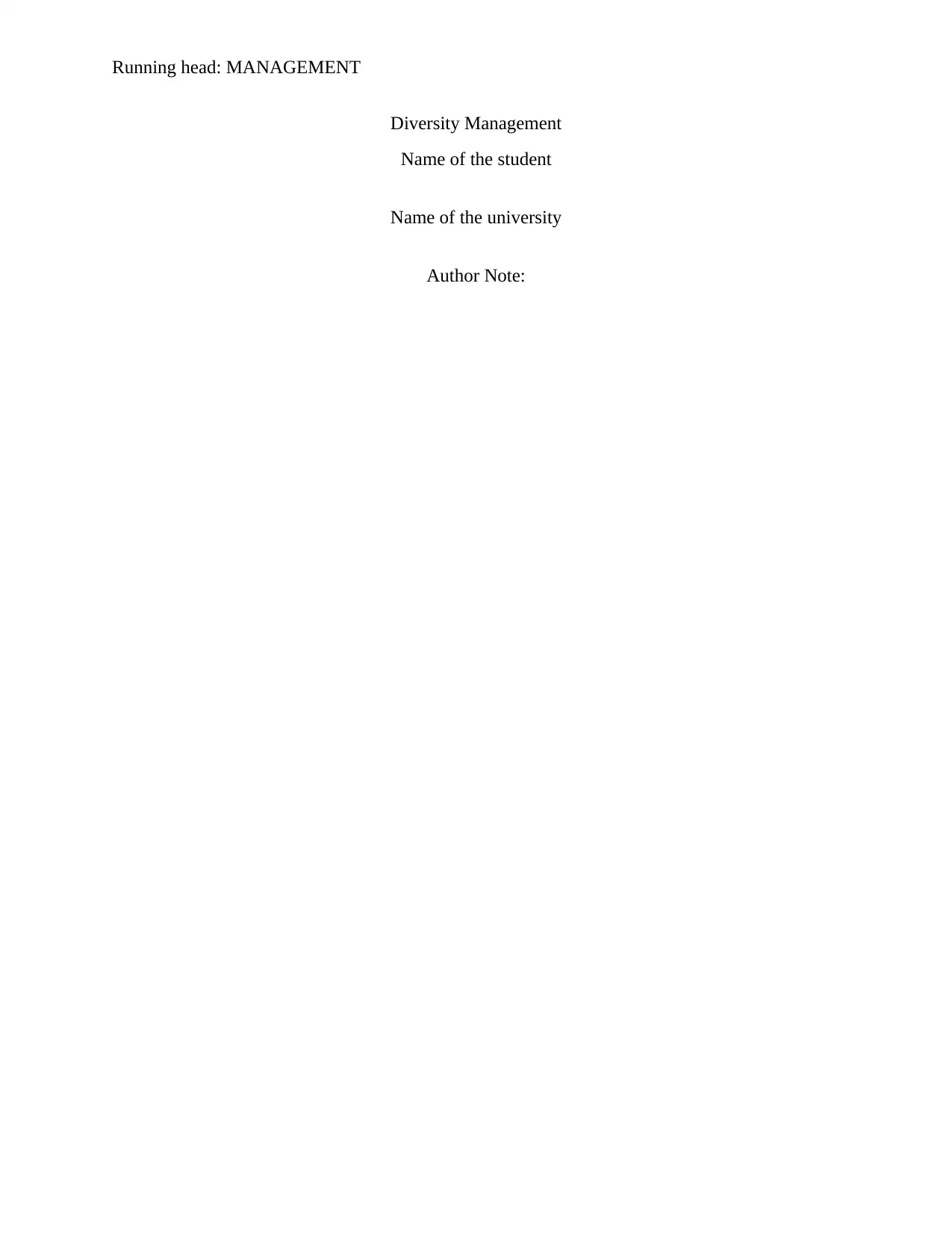
Running head: MANAGEMENT
Diversity Management
Name of the student
Name of the university
Author Note:
Diversity Management
Name of the student
Name of the university
Author Note:
Paraphrase This Document
Need a fresh take? Get an instant paraphrase of this document with our AI Paraphraser
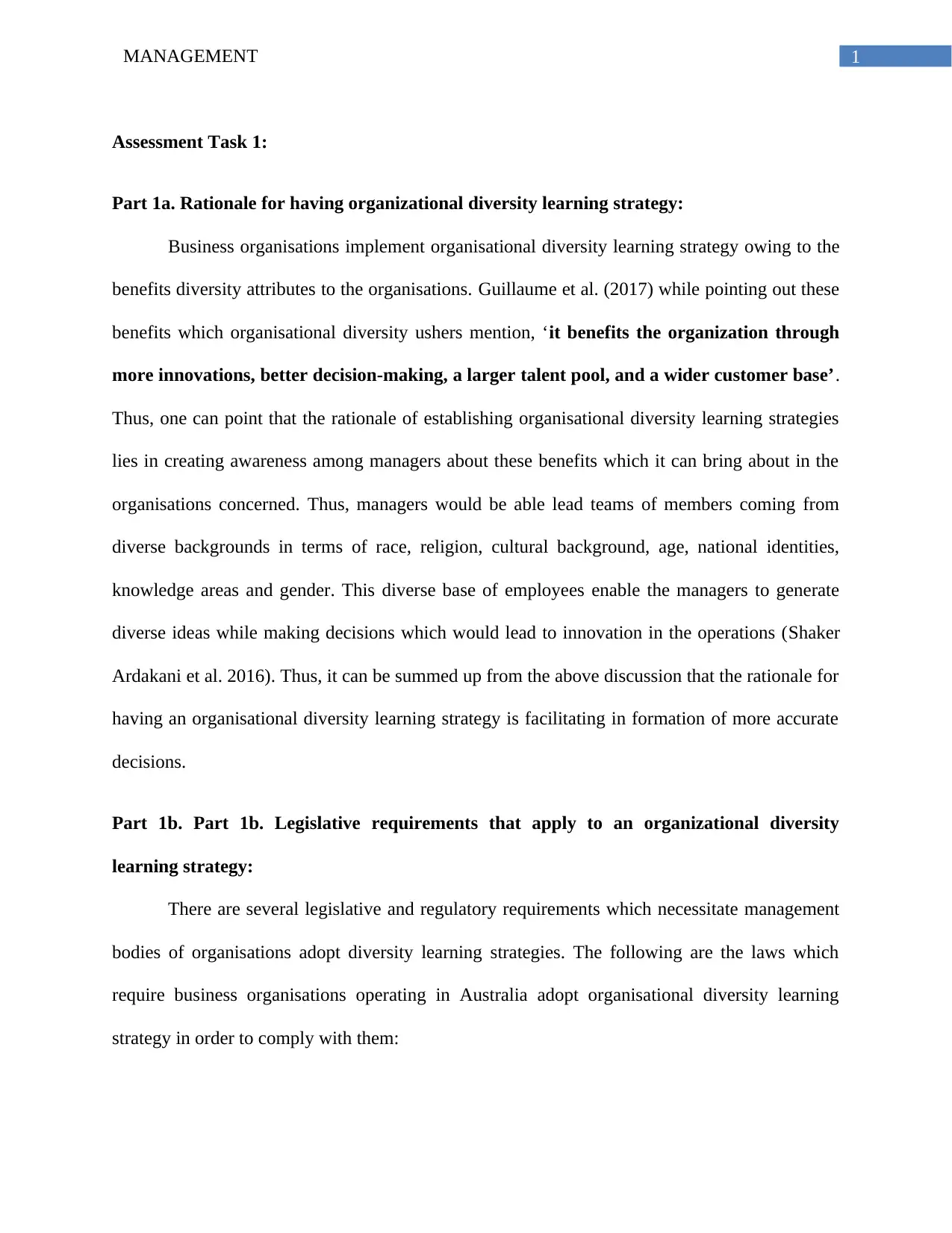
1MANAGEMENT
Assessment Task 1:
Part 1a. Rationale for having organizational diversity learning strategy:
Business organisations implement organisational diversity learning strategy owing to the
benefits diversity attributes to the organisations. Guillaume et al. (2017) while pointing out these
benefits which organisational diversity ushers mention, ‘it benefits the organization through
more innovations, better decision-making, a larger talent pool, and a wider customer base’.
Thus, one can point that the rationale of establishing organisational diversity learning strategies
lies in creating awareness among managers about these benefits which it can bring about in the
organisations concerned. Thus, managers would be able lead teams of members coming from
diverse backgrounds in terms of race, religion, cultural background, age, national identities,
knowledge areas and gender. This diverse base of employees enable the managers to generate
diverse ideas while making decisions which would lead to innovation in the operations (Shaker
Ardakani et al. 2016). Thus, it can be summed up from the above discussion that the rationale for
having an organisational diversity learning strategy is facilitating in formation of more accurate
decisions.
Part 1b. Part 1b. Legislative requirements that apply to an organizational diversity
learning strategy:
There are several legislative and regulatory requirements which necessitate management
bodies of organisations adopt diversity learning strategies. The following are the laws which
require business organisations operating in Australia adopt organisational diversity learning
strategy in order to comply with them:
Assessment Task 1:
Part 1a. Rationale for having organizational diversity learning strategy:
Business organisations implement organisational diversity learning strategy owing to the
benefits diversity attributes to the organisations. Guillaume et al. (2017) while pointing out these
benefits which organisational diversity ushers mention, ‘it benefits the organization through
more innovations, better decision-making, a larger talent pool, and a wider customer base’.
Thus, one can point that the rationale of establishing organisational diversity learning strategies
lies in creating awareness among managers about these benefits which it can bring about in the
organisations concerned. Thus, managers would be able lead teams of members coming from
diverse backgrounds in terms of race, religion, cultural background, age, national identities,
knowledge areas and gender. This diverse base of employees enable the managers to generate
diverse ideas while making decisions which would lead to innovation in the operations (Shaker
Ardakani et al. 2016). Thus, it can be summed up from the above discussion that the rationale for
having an organisational diversity learning strategy is facilitating in formation of more accurate
decisions.
Part 1b. Part 1b. Legislative requirements that apply to an organizational diversity
learning strategy:
There are several legislative and regulatory requirements which necessitate management
bodies of organisations adopt diversity learning strategies. The following are the laws which
require business organisations operating in Australia adopt organisational diversity learning
strategy in order to comply with them:
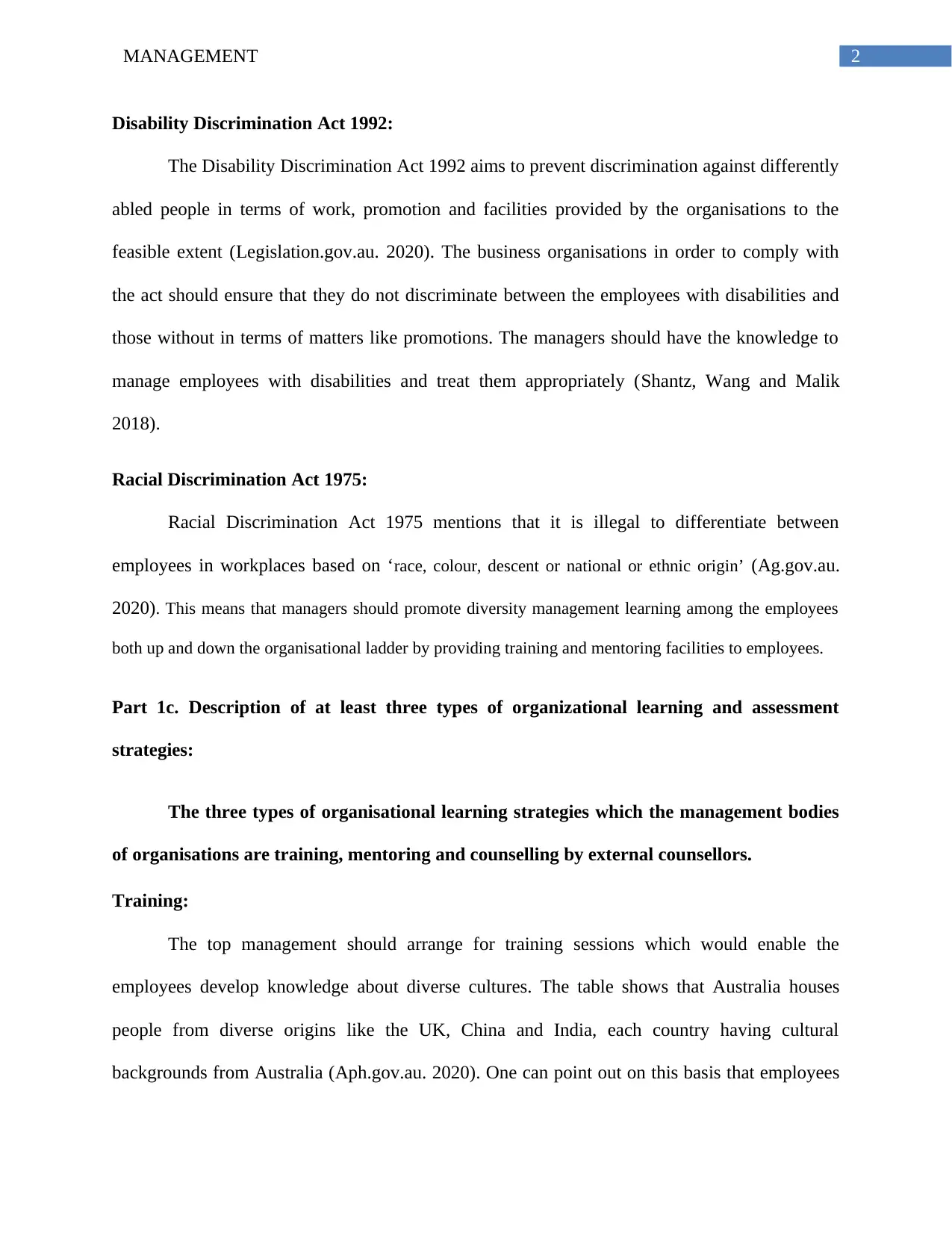
2MANAGEMENT
Disability Discrimination Act 1992:
The Disability Discrimination Act 1992 aims to prevent discrimination against differently
abled people in terms of work, promotion and facilities provided by the organisations to the
feasible extent (Legislation.gov.au. 2020). The business organisations in order to comply with
the act should ensure that they do not discriminate between the employees with disabilities and
those without in terms of matters like promotions. The managers should have the knowledge to
manage employees with disabilities and treat them appropriately (Shantz, Wang and Malik
2018).
Racial Discrimination Act 1975:
Racial Discrimination Act 1975 mentions that it is illegal to differentiate between
employees in workplaces based on ‘race, colour, descent or national or ethnic origin’ (Ag.gov.au.
2020). This means that managers should promote diversity management learning among the employees
both up and down the organisational ladder by providing training and mentoring facilities to employees.
Part 1c. Description of at least three types of organizational learning and assessment
strategies:
The three types of organisational learning strategies which the management bodies
of organisations are training, mentoring and counselling by external counsellors.
Training:
The top management should arrange for training sessions which would enable the
employees develop knowledge about diverse cultures. The table shows that Australia houses
people from diverse origins like the UK, China and India, each country having cultural
backgrounds from Australia (Aph.gov.au. 2020). One can point out on this basis that employees
Disability Discrimination Act 1992:
The Disability Discrimination Act 1992 aims to prevent discrimination against differently
abled people in terms of work, promotion and facilities provided by the organisations to the
feasible extent (Legislation.gov.au. 2020). The business organisations in order to comply with
the act should ensure that they do not discriminate between the employees with disabilities and
those without in terms of matters like promotions. The managers should have the knowledge to
manage employees with disabilities and treat them appropriately (Shantz, Wang and Malik
2018).
Racial Discrimination Act 1975:
Racial Discrimination Act 1975 mentions that it is illegal to differentiate between
employees in workplaces based on ‘race, colour, descent or national or ethnic origin’ (Ag.gov.au.
2020). This means that managers should promote diversity management learning among the employees
both up and down the organisational ladder by providing training and mentoring facilities to employees.
Part 1c. Description of at least three types of organizational learning and assessment
strategies:
The three types of organisational learning strategies which the management bodies
of organisations are training, mentoring and counselling by external counsellors.
Training:
The top management should arrange for training sessions which would enable the
employees develop knowledge about diverse cultures. The table shows that Australia houses
people from diverse origins like the UK, China and India, each country having cultural
backgrounds from Australia (Aph.gov.au. 2020). One can point out on this basis that employees
⊘ This is a preview!⊘
Do you want full access?
Subscribe today to unlock all pages.

Trusted by 1+ million students worldwide
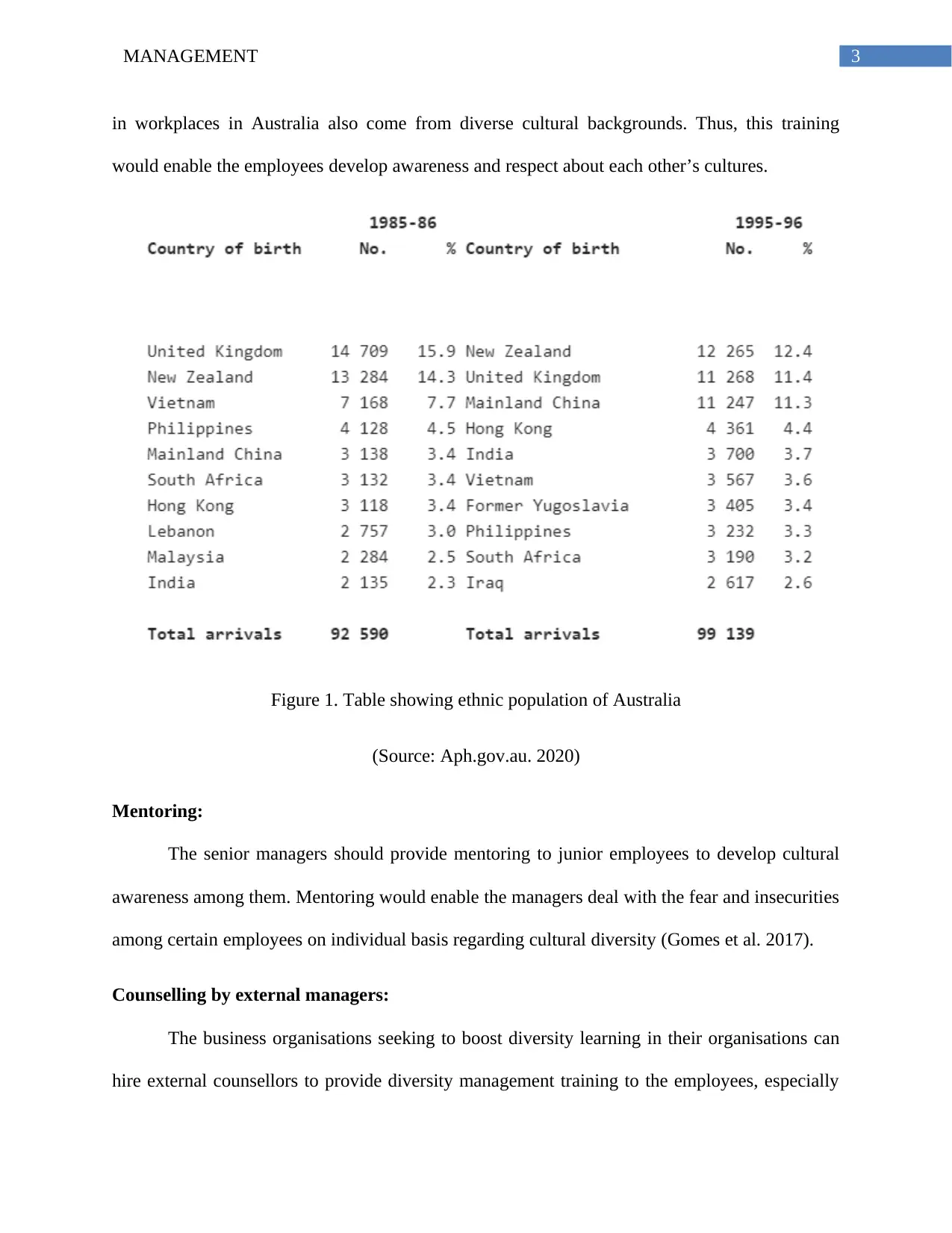
3MANAGEMENT
in workplaces in Australia also come from diverse cultural backgrounds. Thus, this training
would enable the employees develop awareness and respect about each other’s cultures.
Figure 1. Table showing ethnic population of Australia
(Source: Aph.gov.au. 2020)
Mentoring:
The senior managers should provide mentoring to junior employees to develop cultural
awareness among them. Mentoring would enable the managers deal with the fear and insecurities
among certain employees on individual basis regarding cultural diversity (Gomes et al. 2017).
Counselling by external managers:
The business organisations seeking to boost diversity learning in their organisations can
hire external counsellors to provide diversity management training to the employees, especially
in workplaces in Australia also come from diverse cultural backgrounds. Thus, this training
would enable the employees develop awareness and respect about each other’s cultures.
Figure 1. Table showing ethnic population of Australia
(Source: Aph.gov.au. 2020)
Mentoring:
The senior managers should provide mentoring to junior employees to develop cultural
awareness among them. Mentoring would enable the managers deal with the fear and insecurities
among certain employees on individual basis regarding cultural diversity (Gomes et al. 2017).
Counselling by external managers:
The business organisations seeking to boost diversity learning in their organisations can
hire external counsellors to provide diversity management training to the employees, especially
Paraphrase This Document
Need a fresh take? Get an instant paraphrase of this document with our AI Paraphraser
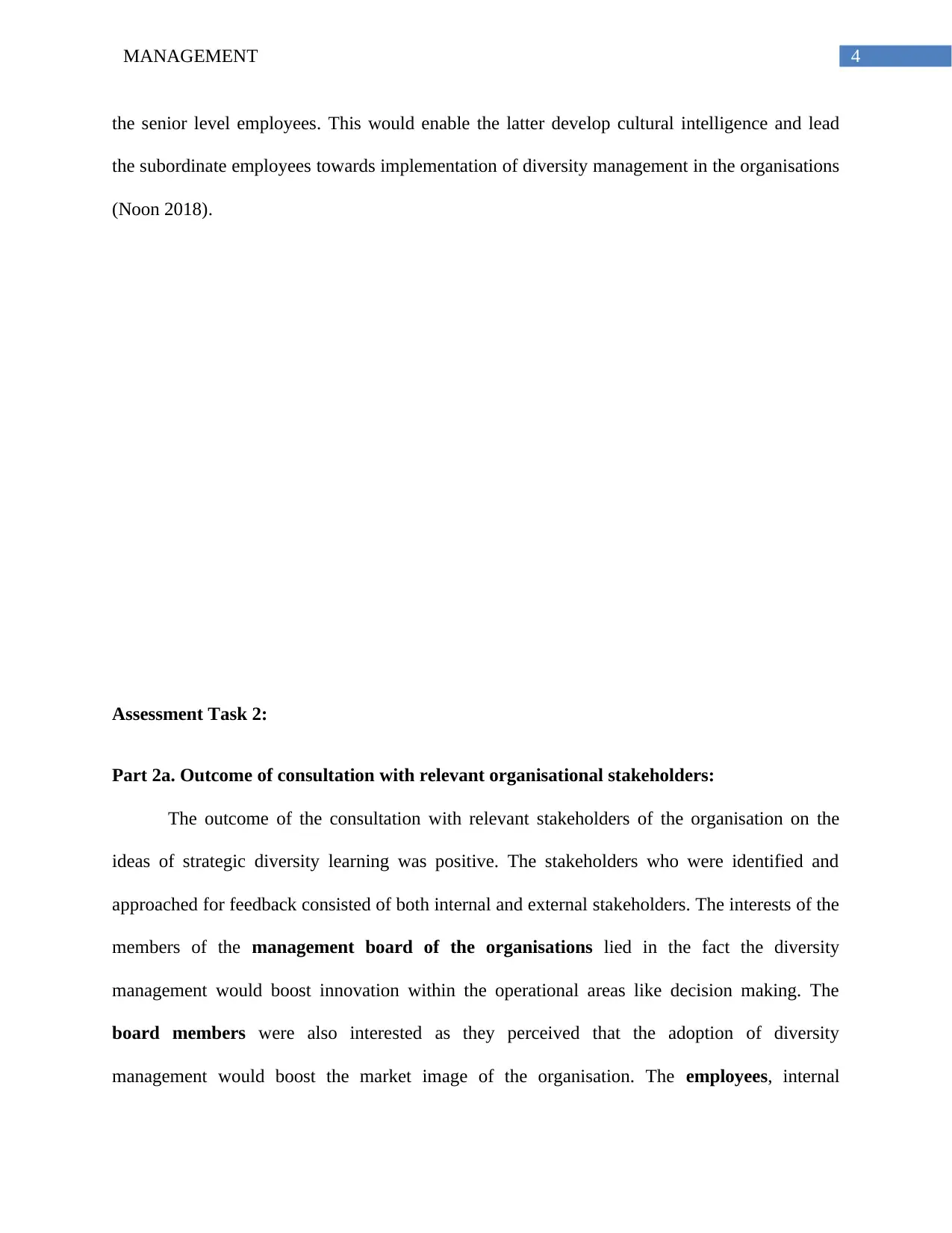
4MANAGEMENT
the senior level employees. This would enable the latter develop cultural intelligence and lead
the subordinate employees towards implementation of diversity management in the organisations
(Noon 2018).
Assessment Task 2:
Part 2a. Outcome of consultation with relevant organisational stakeholders:
The outcome of the consultation with relevant stakeholders of the organisation on the
ideas of strategic diversity learning was positive. The stakeholders who were identified and
approached for feedback consisted of both internal and external stakeholders. The interests of the
members of the management board of the organisations lied in the fact the diversity
management would boost innovation within the operational areas like decision making. The
board members were also interested as they perceived that the adoption of diversity
management would boost the market image of the organisation. The employees, internal
the senior level employees. This would enable the latter develop cultural intelligence and lead
the subordinate employees towards implementation of diversity management in the organisations
(Noon 2018).
Assessment Task 2:
Part 2a. Outcome of consultation with relevant organisational stakeholders:
The outcome of the consultation with relevant stakeholders of the organisation on the
ideas of strategic diversity learning was positive. The stakeholders who were identified and
approached for feedback consisted of both internal and external stakeholders. The interests of the
members of the management board of the organisations lied in the fact the diversity
management would boost innovation within the operational areas like decision making. The
board members were also interested as they perceived that the adoption of diversity
management would boost the market image of the organisation. The employees, internal
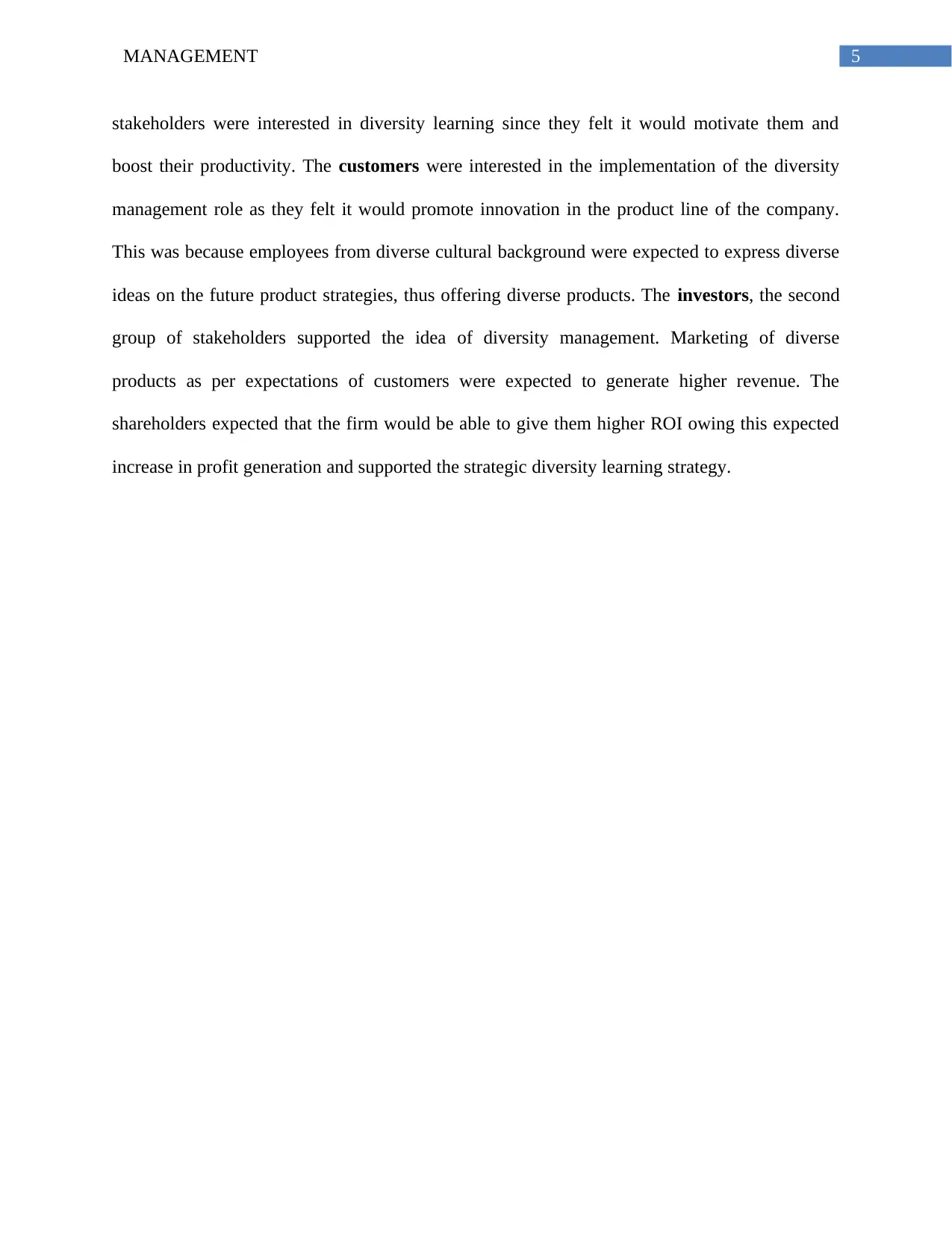
5MANAGEMENT
stakeholders were interested in diversity learning since they felt it would motivate them and
boost their productivity. The customers were interested in the implementation of the diversity
management role as they felt it would promote innovation in the product line of the company.
This was because employees from diverse cultural background were expected to express diverse
ideas on the future product strategies, thus offering diverse products. The investors, the second
group of stakeholders supported the idea of diversity management. Marketing of diverse
products as per expectations of customers were expected to generate higher revenue. The
shareholders expected that the firm would be able to give them higher ROI owing this expected
increase in profit generation and supported the strategic diversity learning strategy.
stakeholders were interested in diversity learning since they felt it would motivate them and
boost their productivity. The customers were interested in the implementation of the diversity
management role as they felt it would promote innovation in the product line of the company.
This was because employees from diverse cultural background were expected to express diverse
ideas on the future product strategies, thus offering diverse products. The investors, the second
group of stakeholders supported the idea of diversity management. Marketing of diverse
products as per expectations of customers were expected to generate higher revenue. The
shareholders expected that the firm would be able to give them higher ROI owing this expected
increase in profit generation and supported the strategic diversity learning strategy.
⊘ This is a preview!⊘
Do you want full access?
Subscribe today to unlock all pages.

Trusted by 1+ million students worldwide
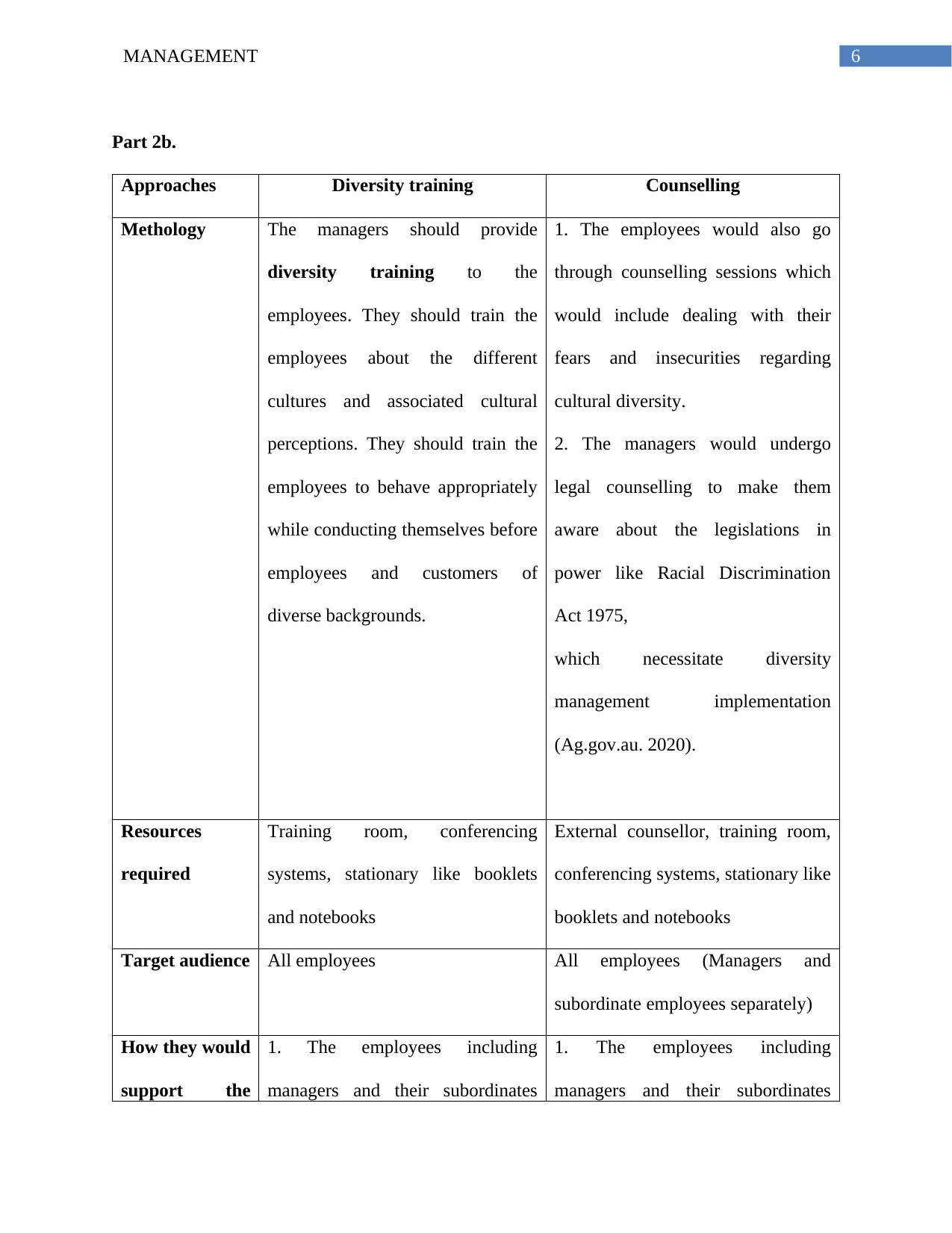
6MANAGEMENT
Part 2b.
Approaches Diversity training Counselling
Methology The managers should provide
diversity training to the
employees. They should train the
employees about the different
cultures and associated cultural
perceptions. They should train the
employees to behave appropriately
while conducting themselves before
employees and customers of
diverse backgrounds.
1. The employees would also go
through counselling sessions which
would include dealing with their
fears and insecurities regarding
cultural diversity.
2. The managers would undergo
legal counselling to make them
aware about the legislations in
power like Racial Discrimination
Act 1975,
which necessitate diversity
management implementation
(Ag.gov.au. 2020).
Resources
required
Training room, conferencing
systems, stationary like booklets
and notebooks
External counsellor, training room,
conferencing systems, stationary like
booklets and notebooks
Target audience All employees All employees (Managers and
subordinate employees separately)
How they would
support the
1. The employees including
managers and their subordinates
1. The employees including
managers and their subordinates
Part 2b.
Approaches Diversity training Counselling
Methology The managers should provide
diversity training to the
employees. They should train the
employees about the different
cultures and associated cultural
perceptions. They should train the
employees to behave appropriately
while conducting themselves before
employees and customers of
diverse backgrounds.
1. The employees would also go
through counselling sessions which
would include dealing with their
fears and insecurities regarding
cultural diversity.
2. The managers would undergo
legal counselling to make them
aware about the legislations in
power like Racial Discrimination
Act 1975,
which necessitate diversity
management implementation
(Ag.gov.au. 2020).
Resources
required
Training room, conferencing
systems, stationary like booklets
and notebooks
External counsellor, training room,
conferencing systems, stationary like
booklets and notebooks
Target audience All employees All employees (Managers and
subordinate employees separately)
How they would
support the
1. The employees including
managers and their subordinates
1. The employees including
managers and their subordinates
Paraphrase This Document
Need a fresh take? Get an instant paraphrase of this document with our AI Paraphraser
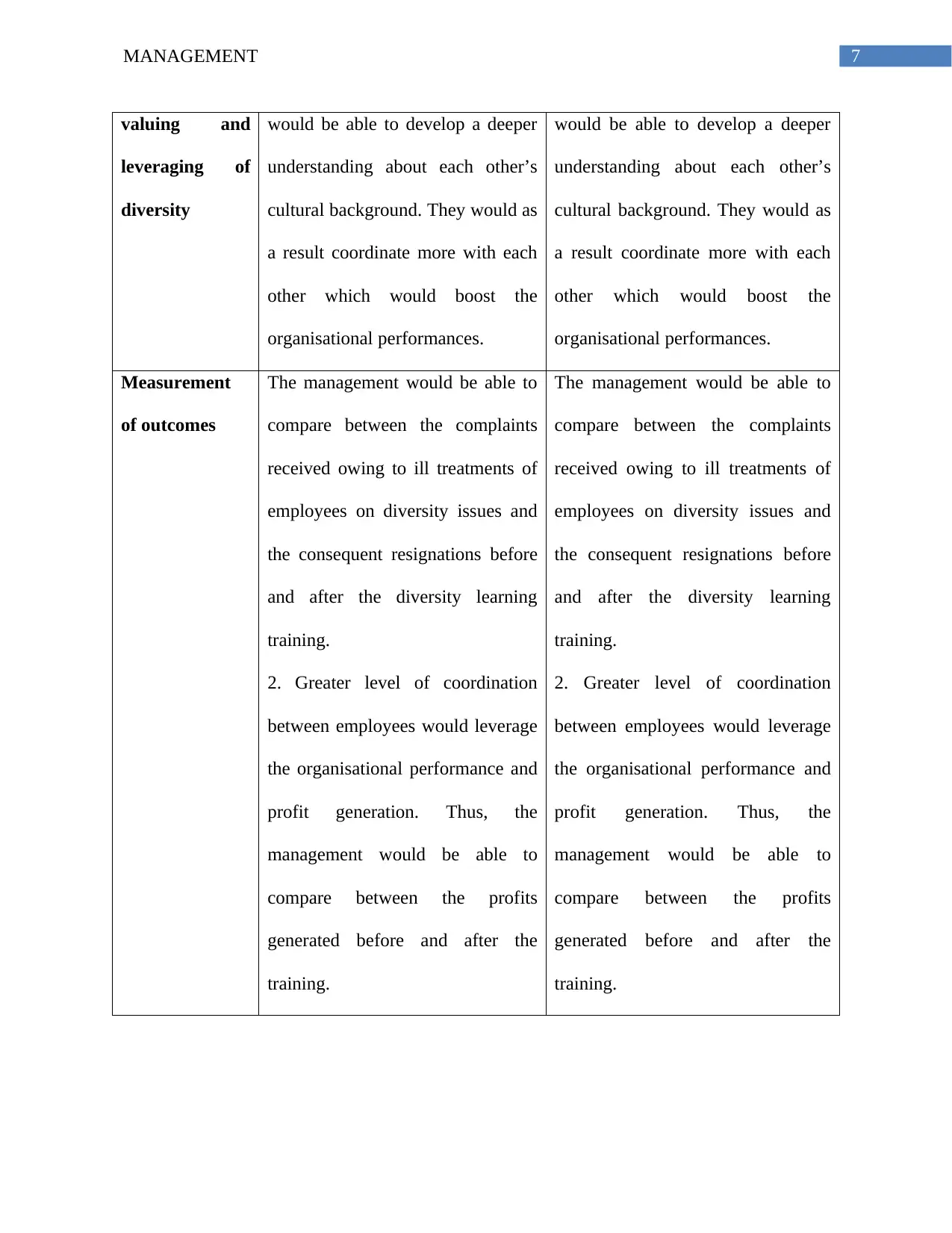
7MANAGEMENT
valuing and
leveraging of
diversity
would be able to develop a deeper
understanding about each other’s
cultural background. They would as
a result coordinate more with each
other which would boost the
organisational performances.
would be able to develop a deeper
understanding about each other’s
cultural background. They would as
a result coordinate more with each
other which would boost the
organisational performances.
Measurement
of outcomes
The management would be able to
compare between the complaints
received owing to ill treatments of
employees on diversity issues and
the consequent resignations before
and after the diversity learning
training.
2. Greater level of coordination
between employees would leverage
the organisational performance and
profit generation. Thus, the
management would be able to
compare between the profits
generated before and after the
training.
The management would be able to
compare between the complaints
received owing to ill treatments of
employees on diversity issues and
the consequent resignations before
and after the diversity learning
training.
2. Greater level of coordination
between employees would leverage
the organisational performance and
profit generation. Thus, the
management would be able to
compare between the profits
generated before and after the
training.
valuing and
leveraging of
diversity
would be able to develop a deeper
understanding about each other’s
cultural background. They would as
a result coordinate more with each
other which would boost the
organisational performances.
would be able to develop a deeper
understanding about each other’s
cultural background. They would as
a result coordinate more with each
other which would boost the
organisational performances.
Measurement
of outcomes
The management would be able to
compare between the complaints
received owing to ill treatments of
employees on diversity issues and
the consequent resignations before
and after the diversity learning
training.
2. Greater level of coordination
between employees would leverage
the organisational performance and
profit generation. Thus, the
management would be able to
compare between the profits
generated before and after the
training.
The management would be able to
compare between the complaints
received owing to ill treatments of
employees on diversity issues and
the consequent resignations before
and after the diversity learning
training.
2. Greater level of coordination
between employees would leverage
the organisational performance and
profit generation. Thus, the
management would be able to
compare between the profits
generated before and after the
training.
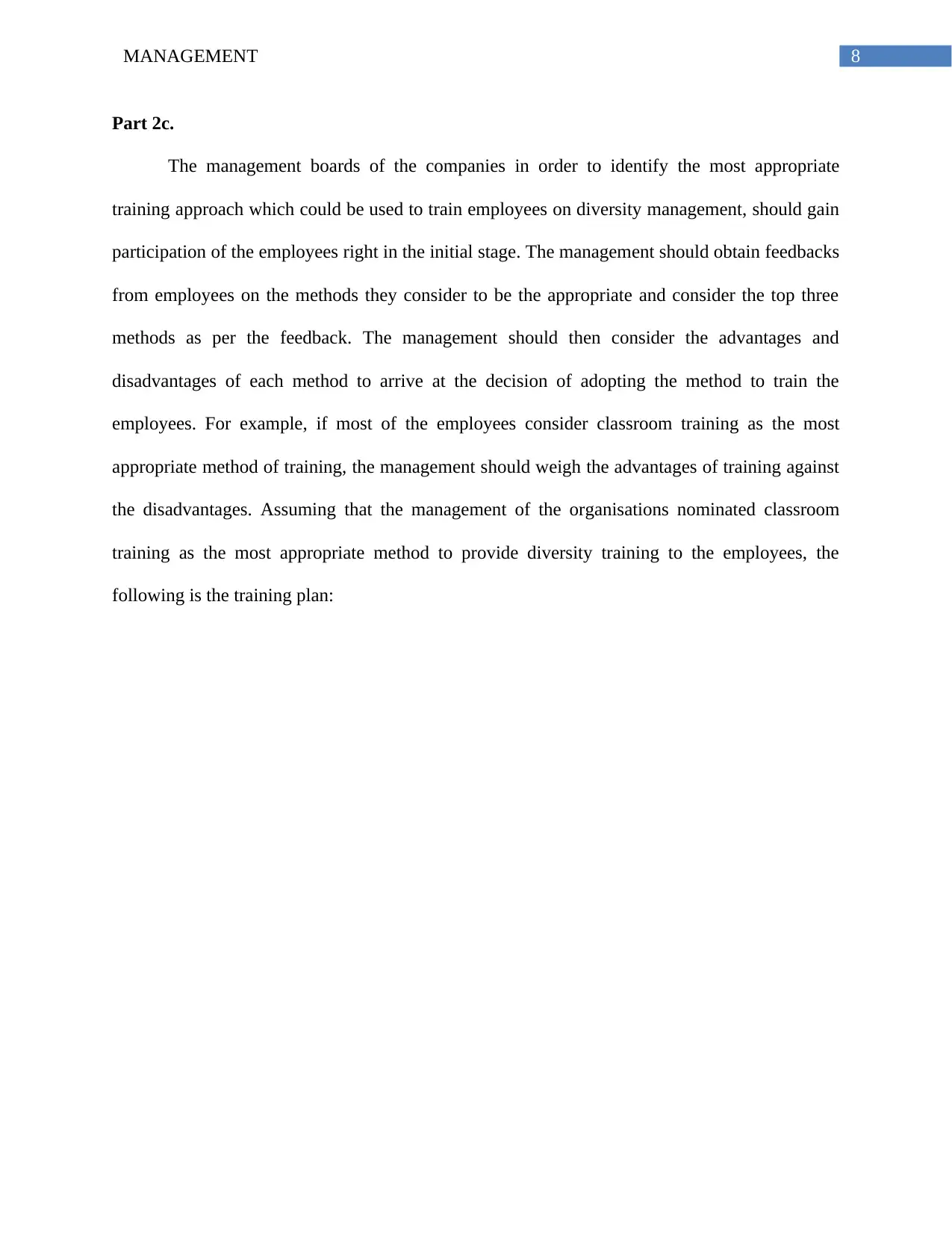
8MANAGEMENT
Part 2c.
The management boards of the companies in order to identify the most appropriate
training approach which could be used to train employees on diversity management, should gain
participation of the employees right in the initial stage. The management should obtain feedbacks
from employees on the methods they consider to be the appropriate and consider the top three
methods as per the feedback. The management should then consider the advantages and
disadvantages of each method to arrive at the decision of adopting the method to train the
employees. For example, if most of the employees consider classroom training as the most
appropriate method of training, the management should weigh the advantages of training against
the disadvantages. Assuming that the management of the organisations nominated classroom
training as the most appropriate method to provide diversity training to the employees, the
following is the training plan:
Part 2c.
The management boards of the companies in order to identify the most appropriate
training approach which could be used to train employees on diversity management, should gain
participation of the employees right in the initial stage. The management should obtain feedbacks
from employees on the methods they consider to be the appropriate and consider the top three
methods as per the feedback. The management should then consider the advantages and
disadvantages of each method to arrive at the decision of adopting the method to train the
employees. For example, if most of the employees consider classroom training as the most
appropriate method of training, the management should weigh the advantages of training against
the disadvantages. Assuming that the management of the organisations nominated classroom
training as the most appropriate method to provide diversity training to the employees, the
following is the training plan:
⊘ This is a preview!⊘
Do you want full access?
Subscribe today to unlock all pages.

Trusted by 1+ million students worldwide
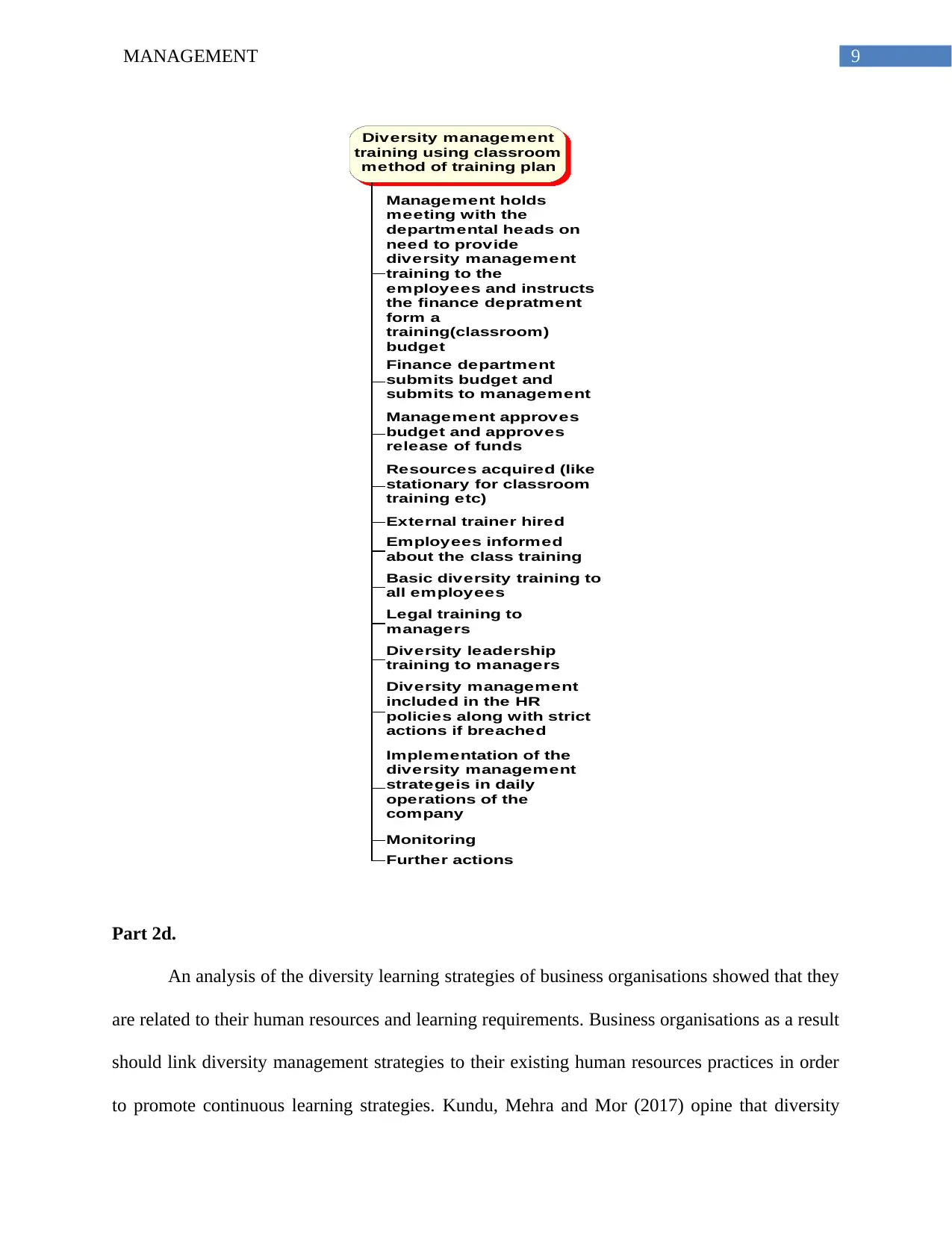
9MANAGEMENT
Diversity management
training using classroom
method of training plan
Management holds
meeting with the
departmental heads on
need to provide
diversity management
training to the
employees and instructs
the finance depratment
form a
training(classroom)
budget
Finance department
submits budget and
submits to management
Management approves
budget and approves
release of funds
Resources acquired (like
stationary for classroom
training etc)
External trainer hired
Employees informed
about the class training
Basic diversity training to
all employees
Legal training to
managers
Diversity leadership
training to managers
Diversity management
included in the HR
policies along with strict
actions if breached
Implementation of the
diversity management
strategeis in daily
operations of the
company
Monitoring
Further actions
Part 2d.
An analysis of the diversity learning strategies of business organisations showed that they
are related to their human resources and learning requirements. Business organisations as a result
should link diversity management strategies to their existing human resources practices in order
to promote continuous learning strategies. Kundu, Mehra and Mor (2017) opine that diversity
Diversity management
training using classroom
method of training plan
Management holds
meeting with the
departmental heads on
need to provide
diversity management
training to the
employees and instructs
the finance depratment
form a
training(classroom)
budget
Finance department
submits budget and
submits to management
Management approves
budget and approves
release of funds
Resources acquired (like
stationary for classroom
training etc)
External trainer hired
Employees informed
about the class training
Basic diversity training to
all employees
Legal training to
managers
Diversity leadership
training to managers
Diversity management
included in the HR
policies along with strict
actions if breached
Implementation of the
diversity management
strategeis in daily
operations of the
company
Monitoring
Further actions
Part 2d.
An analysis of the diversity learning strategies of business organisations showed that they
are related to their human resources and learning requirements. Business organisations as a result
should link diversity management strategies to their existing human resources practices in order
to promote continuous learning strategies. Kundu, Mehra and Mor (2017) opine that diversity
Paraphrase This Document
Need a fresh take? Get an instant paraphrase of this document with our AI Paraphraser
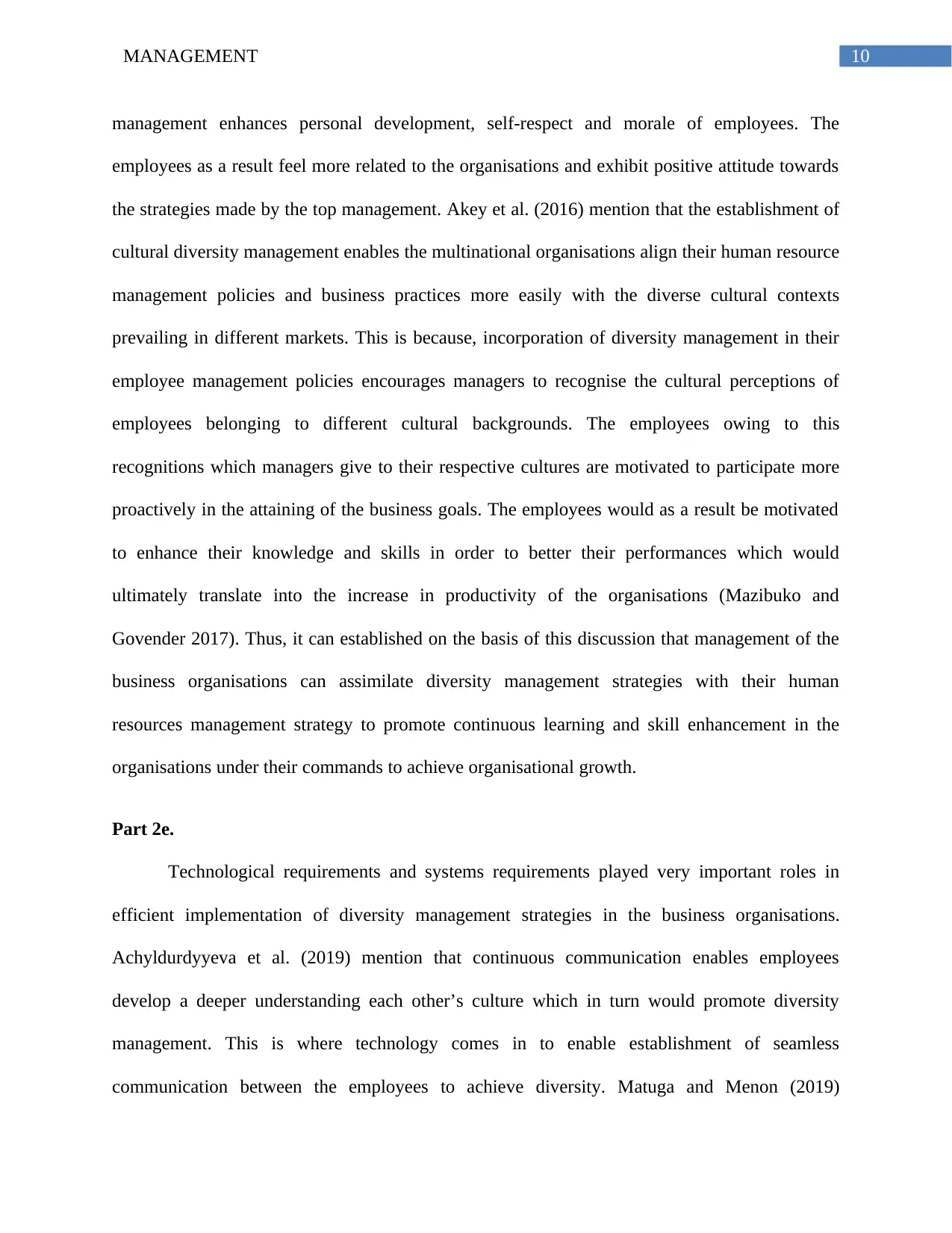
10MANAGEMENT
management enhances personal development, self-respect and morale of employees. The
employees as a result feel more related to the organisations and exhibit positive attitude towards
the strategies made by the top management. Akey et al. (2016) mention that the establishment of
cultural diversity management enables the multinational organisations align their human resource
management policies and business practices more easily with the diverse cultural contexts
prevailing in different markets. This is because, incorporation of diversity management in their
employee management policies encourages managers to recognise the cultural perceptions of
employees belonging to different cultural backgrounds. The employees owing to this
recognitions which managers give to their respective cultures are motivated to participate more
proactively in the attaining of the business goals. The employees would as a result be motivated
to enhance their knowledge and skills in order to better their performances which would
ultimately translate into the increase in productivity of the organisations (Mazibuko and
Govender 2017). Thus, it can established on the basis of this discussion that management of the
business organisations can assimilate diversity management strategies with their human
resources management strategy to promote continuous learning and skill enhancement in the
organisations under their commands to achieve organisational growth.
Part 2e.
Technological requirements and systems requirements played very important roles in
efficient implementation of diversity management strategies in the business organisations.
Achyldurdyyeva et al. (2019) mention that continuous communication enables employees
develop a deeper understanding each other’s culture which in turn would promote diversity
management. This is where technology comes in to enable establishment of seamless
communication between the employees to achieve diversity. Matuga and Menon (2019)
management enhances personal development, self-respect and morale of employees. The
employees as a result feel more related to the organisations and exhibit positive attitude towards
the strategies made by the top management. Akey et al. (2016) mention that the establishment of
cultural diversity management enables the multinational organisations align their human resource
management policies and business practices more easily with the diverse cultural contexts
prevailing in different markets. This is because, incorporation of diversity management in their
employee management policies encourages managers to recognise the cultural perceptions of
employees belonging to different cultural backgrounds. The employees owing to this
recognitions which managers give to their respective cultures are motivated to participate more
proactively in the attaining of the business goals. The employees would as a result be motivated
to enhance their knowledge and skills in order to better their performances which would
ultimately translate into the increase in productivity of the organisations (Mazibuko and
Govender 2017). Thus, it can established on the basis of this discussion that management of the
business organisations can assimilate diversity management strategies with their human
resources management strategy to promote continuous learning and skill enhancement in the
organisations under their commands to achieve organisational growth.
Part 2e.
Technological requirements and systems requirements played very important roles in
efficient implementation of diversity management strategies in the business organisations.
Achyldurdyyeva et al. (2019) mention that continuous communication enables employees
develop a deeper understanding each other’s culture which in turn would promote diversity
management. This is where technology comes in to enable establishment of seamless
communication between the employees to achieve diversity. Matuga and Menon (2019)
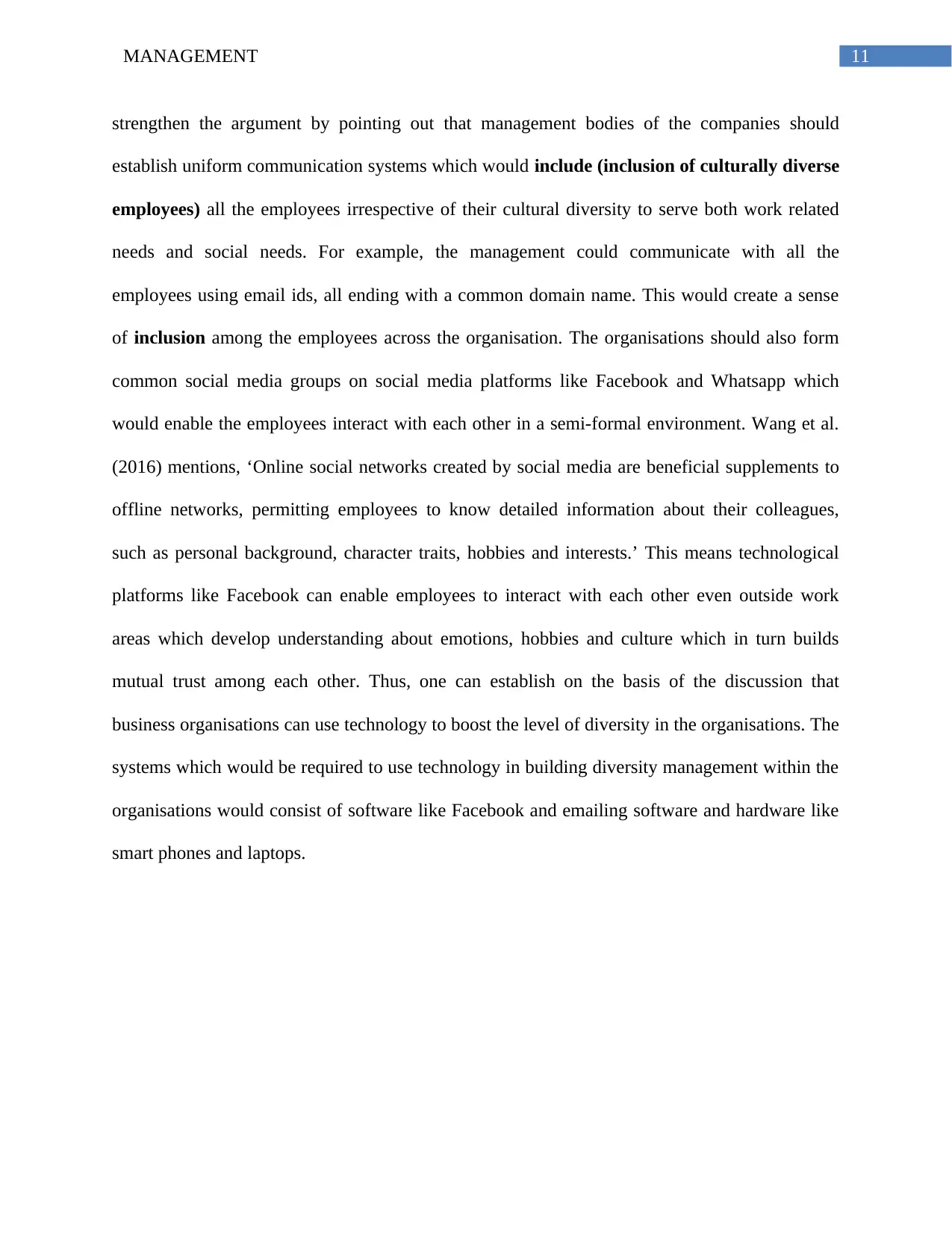
11MANAGEMENT
strengthen the argument by pointing out that management bodies of the companies should
establish uniform communication systems which would include (inclusion of culturally diverse
employees) all the employees irrespective of their cultural diversity to serve both work related
needs and social needs. For example, the management could communicate with all the
employees using email ids, all ending with a common domain name. This would create a sense
of inclusion among the employees across the organisation. The organisations should also form
common social media groups on social media platforms like Facebook and Whatsapp which
would enable the employees interact with each other in a semi-formal environment. Wang et al.
(2016) mentions, ‘Online social networks created by social media are beneficial supplements to
offline networks, permitting employees to know detailed information about their colleagues,
such as personal background, character traits, hobbies and interests.’ This means technological
platforms like Facebook can enable employees to interact with each other even outside work
areas which develop understanding about emotions, hobbies and culture which in turn builds
mutual trust among each other. Thus, one can establish on the basis of the discussion that
business organisations can use technology to boost the level of diversity in the organisations. The
systems which would be required to use technology in building diversity management within the
organisations would consist of software like Facebook and emailing software and hardware like
smart phones and laptops.
strengthen the argument by pointing out that management bodies of the companies should
establish uniform communication systems which would include (inclusion of culturally diverse
employees) all the employees irrespective of their cultural diversity to serve both work related
needs and social needs. For example, the management could communicate with all the
employees using email ids, all ending with a common domain name. This would create a sense
of inclusion among the employees across the organisation. The organisations should also form
common social media groups on social media platforms like Facebook and Whatsapp which
would enable the employees interact with each other in a semi-formal environment. Wang et al.
(2016) mentions, ‘Online social networks created by social media are beneficial supplements to
offline networks, permitting employees to know detailed information about their colleagues,
such as personal background, character traits, hobbies and interests.’ This means technological
platforms like Facebook can enable employees to interact with each other even outside work
areas which develop understanding about emotions, hobbies and culture which in turn builds
mutual trust among each other. Thus, one can establish on the basis of the discussion that
business organisations can use technology to boost the level of diversity in the organisations. The
systems which would be required to use technology in building diversity management within the
organisations would consist of software like Facebook and emailing software and hardware like
smart phones and laptops.
⊘ This is a preview!⊘
Do you want full access?
Subscribe today to unlock all pages.

Trusted by 1+ million students worldwide
1 out of 25
Related Documents
Your All-in-One AI-Powered Toolkit for Academic Success.
+13062052269
info@desklib.com
Available 24*7 on WhatsApp / Email
![[object Object]](/_next/static/media/star-bottom.7253800d.svg)
Unlock your academic potential
Copyright © 2020–2025 A2Z Services. All Rights Reserved. Developed and managed by ZUCOL.




